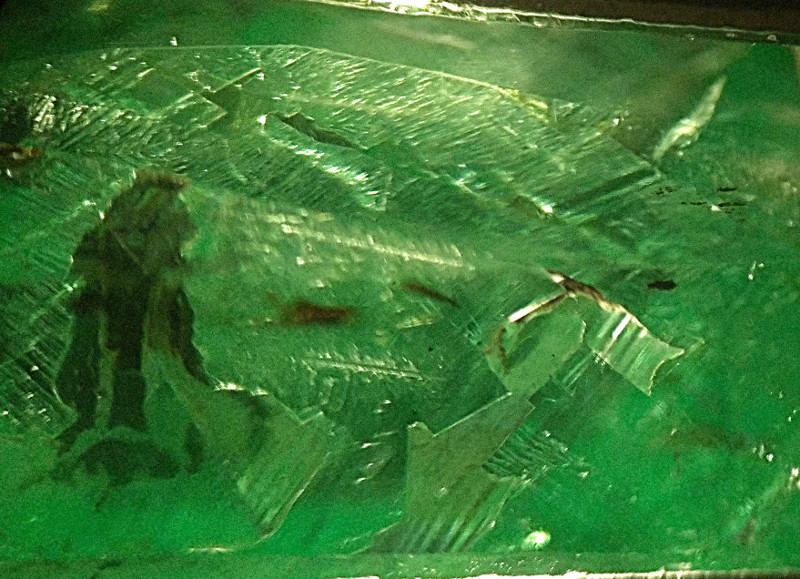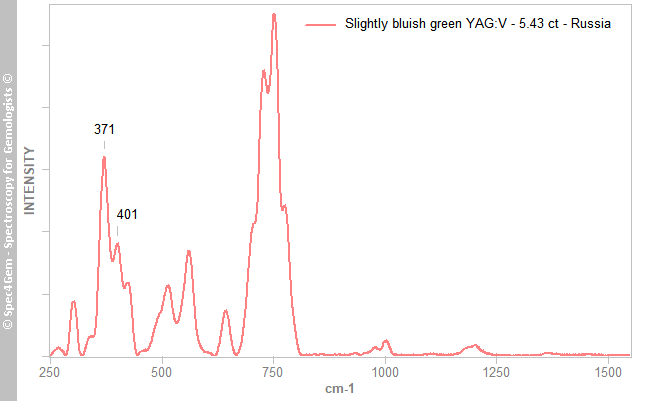A 5.43 ct Vanadium-doped YAG with an emerald color from Russia
- Details
- Created: Saturday, 14 June 2025 12:01
The YAG, an Yttrium-Aluminum Garnet is a man-made material with a garnet structure that does not have its counterpart in nature. It is mainly used in lasers and sometimes in jewelry as diamond simulant when colorless, emerald simulant when green, etc. When pure it is colorless, but doped with REE, Cr or V, it gives a wide range of colors.
The YAG gemstone shown in the Figure 1 was made in Russia likely decays ago and displays an interesting color as some emeralds or 'mint' garnets (pale tsavorite garnets). Despite its lovely color, its appearance is depreciated by its numerous internal features and additionally the two right corners are broken. The Figure 2 shows an overview of the healed cracks possibly with melt residues, growth issues, highly reflective features that appear black in some directions compared to colorless in other ones, see bottom part of the Figure 1. The Figure 3 shows features that resemble to parallel growth tubes.
 Figure 1. The 5.43 ct emerald green YAG measures 10.8 x 7.1 x 5.2
Figure 1. The 5.43 ct emerald green YAG measures 10.8 x 7.1 x 5.2mm. Some highly reflective internal features make the gemstone
windowed where it should not (lower gemstone's border at the
bottom of the photography).
| Shape | rectangular step cut |
| Size | 10.8 x 7.1 x 5.2 mm |
| Color | slightly bluish green |
| Diaphaneity | transparent |
| Lustre | vitreous |
| Weight | 5.43 ct |
| SG | 4.58 [4.50 - 4.75] |
| RI | ~1.82 [1.820 - 1.835] |
| DR | - |
| Pleochroism | - |
| Polariscope / Conoscope | light through 360°: isotropic |
| SWUV | orange, weak to medium |
| LWUV | orange, strong |
| Magnetic susceptibility N52 | moderately attracted by the magnet |
| Chelsea filter | green, no reaction |
Table 1. Observational and measured properties

Figure 2. Overview of the healed cracks possibly with melt residues, growth issues, highly reflective features that appear black in some
directions compared to colorless in other ones (see bottom part of the Figure 1).
Raman spectroscopy:
The Raman spectrum with a 636 nm laser is shown in the Figure 4, two diagnostic peaks at 371 and 401 cm-1 indicate the material is an YAG. The spectrum contains several other Raman peaks which are not related to any luminescence, they are not useful to identify the YAG.
 Figure 4. The Raman spectrum of this 5.43 ct emerald green YAG shows the YAG's diagnostic peaks at 371 and 401 cm-1.
Figure 4. The Raman spectrum of this 5.43 ct emerald green YAG shows the YAG's diagnostic peaks at 371 and 401 cm-1.UV-VIS-NIR spectroscopy:
The UV-VIS-NIR spectrum covering the 370 - 1000 nm is shown in the Figure 5. It shows the tail of a strong absorption below 400 nm, a relatively narrow band centered at 427 nm and three weaker but wider bands at 617, 700 and 809 nm. There is also a small absorption feature between 805 and 810 nm. The 427 and 617 nm bands are consistent with Vanadium bands as V3+ (Ma et al., 2006[1]) and they create a transmission window centered at 520 nm which results in the green color of the gemstone. The 617 nm bands may suggest there was a post growth annealing in air for few hours, since the corresponding shifts from 595 to 614 nm in this context (Lagutaa et al., 2019[2]). The 805-810 nm small feature could be the remaining of the 822 nm strong band after that post-growth treatment but the wider band at 809 nm should be less important. At the time of writing, the wide bands at 700 nm remain unexplained, could it be the result of F-centers caused by irradiations (ionizing radiations)?
 Figure 5. The absorption spectrum of this 5.43 ct emerald green YAG shows bands at 427, 617, 700 and 809 nm with a small feature between 805 and 810 nm. The bands' positions were obtained by Gaussian-deconvolution.
Figure 5. The absorption spectrum of this 5.43 ct emerald green YAG shows bands at 427, 617, 700 and 809 nm with a small feature between 805 and 810 nm. The bands' positions were obtained by Gaussian-deconvolution.Photoluminescence spectroscopy:
The photoluminescence spectroscopy of this 5.43 ct emerald green YAG was performed with 373 and 405 nm excitation sources. The corresponding spectra are shown in the Figure 6 and indicate emissions related to REE. At the time of writing, no real matching with the common emissions found with Er, Nd, Ho, Tm, etc., further investigations are needed.
 Figure 6. The photoluminescence spectra of this 5.43 ct emerald green YAG collected with 373 and 405 nm excitation sources show emissions related to REE.
Figure 6. The photoluminescence spectra of this 5.43 ct emerald green YAG collected with 373 and 405 nm excitation sources show emissions related to REE.Conclusion:
The slightly bluish green color of this YAG, lesser bluish than for common V-doped YAG, is nevertheless attractive and was possibly obtained by post-growth annealing treatment, irradiation could not be confirmed.
[1] Spectroscopic investigation of YAG crystal doped with tetrahedrally coordinated V3+ ions, Jian Ma, Maolu Du, and Feng Miao, Phys. Stat. Sol. (b) 243, 2006, No. 8, pp. 1785–1790
[2] Vanadium in yttrium aluminum garnet: Charge states and localization in the lattice, V. Lagutaa, M. Buryia, A. Beitlerovaa, O. Lagutab, K. Nejezchlebc and M. Nikl, Optical Materials, 2019, Volume 91, pp. 228-234


